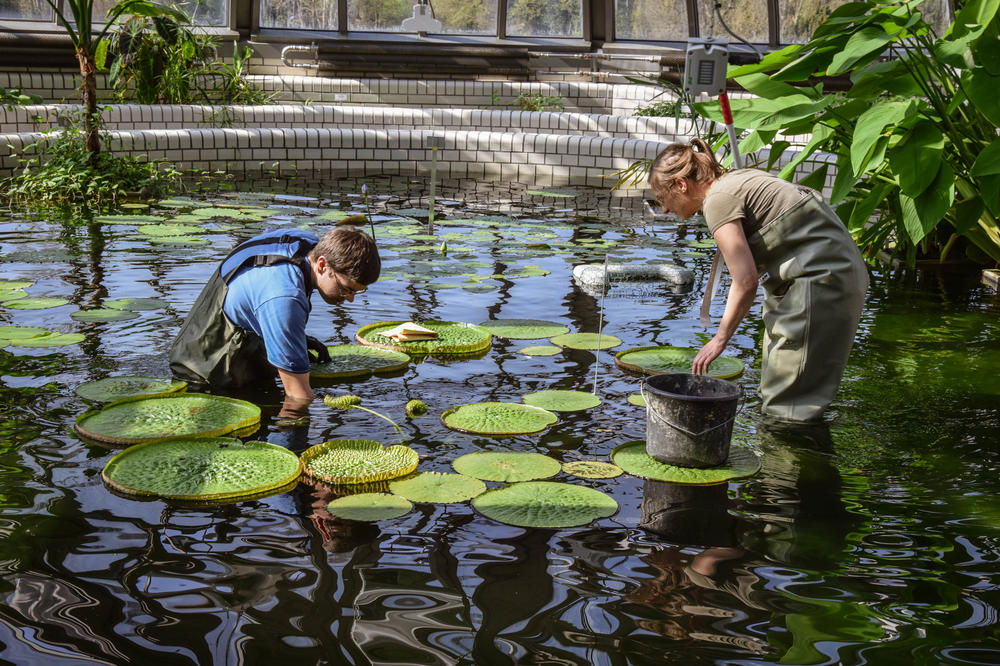Understanding Plants
Research Project at the Botanical Gardens and Botanical Museum
Sep 09, 2020
Researchers at the Botanical Garden are investigating the relationship between plants and humans.
Image Credit: Ch. Hillmann-Huber
“Humans think anthropocentrically; that is, we see everything from a human point of view. We rarely consider other forms of life on their own terms,” says social and cultural anthropologist Sandra Calkins from Freie Universität Berlin. “In particular, we perceive plants as being passive and mainly consider how useful they are for humans. Hence, we rarely notice their own forms of expression.” In light of climate change, species extinction, and the fragile relationships between humans and their environment, it might be helpful to question this human-centered attitude.
Sensual Experiences
In a new, interdisciplinary research project led by Sandra Calkins and Albert-Dieter Stevens, who heads the Biological Collections of the Botanical Garden and Botanical Museum Berlin (BGBM), scientists are examining everyday encounters between humans and plants in the Botanical Gardens to understand their affective potential. “In particular, we examine the role of sensory experience in this interspecies encounter and explore its potential to confirm or transform institutional orders that categorically separate humans and plants,” says Sandra Calkins.
The research project is being conducted within the Collaborative Research Center “Affective Societies” at Freie Universität, which posits affects and emotions as fundamental moments of social life. Affect is taken to be a spontaneous physical and reciprocal reaction that is evoked by an encounter. In contrast, they speak of emotions when such affective dynamics are channeled into culturally established and conventionalized responses. “To date most thinking about affects and emotions concerns the relationships between people. Much less attention has been paid to the relationships between species,” says Sandra Calkins, adding that dealing with affective dynamics across seemingly rigid species boundaries raises political questions about our dealings with and responsibility for nonhuman beings.
Interviews and Observation
The researchers work with three groups of people who deal with plants in the Botanical Garden and Botanical Museum: botanists, gardeners, and visitors. “We assume that we can learn a lot from the employees in the museum and gardens about how we can encounter plants on terms closer to their own,” says Sandra Calkins. On the one hand, the research team will study implicit knowledge about plants in everyday routines of plant care and how both gardeners and botanists have trained their sensory perceptions to gain a better understanding of plants’ needs and wants. On the other hand, they want to learn about the experiences that these plant experts made in view of the global extinction of species. “Botanists in particular have the diversity of the species in mind and sometimes directly observe the loss of plant species over the course of years. We are interested in exploring how this affects them personally,” explains Sandra Calkins.
The research methods are multifaceted. “We conduct interviews, but above all, we do participant observation. This means we accompany botanists and gardeners through their daily work and learn by doing, not merely observing,” says Sandra Calkins. For the time after the covid-19 pandemic, they are planning interactive exhibition formats such as a haptic hortus in the Botanical Museum, in which visitors can experience exhibits through touch.
How Do We Want to Deal with Our Environment?
The analyses by Sandra Calkins and her colleagues focus on human–plant relationships within the institutional framework of the BGBM. In the longer term, they would like their research to contribute to larger considerations, such as the theoretical and political consequences that would result if people were to consider plants as sensitive nonhuman counterparts, not only as a passive background for human doings. “Discussions about plant rights and what these could mean for how we organize social life are still in their infancy,” says Sandra Calkins. The latest diversity report by the United Nations shows, however, that about a million plant and animal species will be irretrievably lost in the coming years.
“All forms of life are linked ecologically. Human life is inconceivable without plant life,” states Sandra Calkins, adding, “By expanding our views of plants, we can contribute to rethinking the forms of politics needed to steer through these ecologically uncertain times. Ultimately, how we deal with the environment will determine our future as a species.”
This text originally appeared in German on June 21, 2020, in the Tagesspiegel newspaper supplement published by Freie Universität.
Further Information
Prof. Dr. Sandra Calkins, Institute of Social and Cultural Anthropology, Freie Universität Berlin, Email: s.calkins@fu-berlin.de

